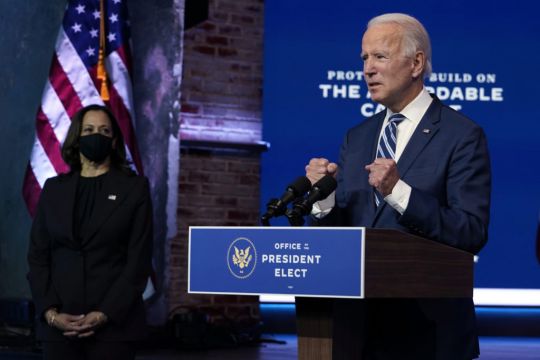Joe Biden is expected to pursue a dramatic shift in US economic policy when he takes office next year faced with multiple challenges.
The President-elect will inherit a vulnerable economic recovery under threat from a resurgent coronavirus, and most likely with a divided Congress that will hinder his ability to address the challenges.
Yet despite the obstacles, the former vice president and senator has vowed to reverse much of the Trump administration’s aggressive deregulation and indifference to domestic spending and economic development, in favour of big investments in education, infrastructure and clean energy.
He also wants stricter rules to rein in big tech companies and to fight climate change.
And to help pay for it all, Mr Biden would turn to large tax increases for corporations and wealthy individuals by reversing much of President Donald Trump’s tax cuts.

Mr Biden is already distinguishing himself from Mr Trump in his approach to the pandemic, which economists generally see as the gravest threat to the recovery.
Mr Trump saw the pandemic’s impact on the economy through the lens of government-mandated shutdowns: He argued that to fight the pandemic by imposing curbs on face-to-face businesses like restaurants — the approach favoured by most health experts — was to doom the economy.
Yet even when states reopened, many consumers stayed cautious about dining out, going to movies or flying.
“It wasn’t all about shutdowns — it was about people getting scared,” said Claudia Sahm, a former Federal Reserve economist. “I imagine people are getting scared again.”
Mr Biden’s view reflects the warning from most economists that until the virus is controlled, the economy cannot fully recover.
“It starts with doing everything possible to get the Covid-19 under control,” Mr Biden said on Monday, “so that we can reopen our businesses safely and sustainably.”
Striking an ominous tone, the President-elect has warned the US is “still facing a very dark winter”, with confirmed cases surging by roughly 120,000 a day — four times the pace of last spring.
That trend, along with colder weather, will severely restrict the outdoor dining that has been a lifeline for restaurants and bars across the country. It could also hamper travel plans and visits to places such as barber shops and yoga studios.
That slower growth, in turn, could intensify calls for more stimulus spending. Most economists, along with Federal Reserve Chair Jerome Powell, are warning the economy needs more rescue aid from Congress.
The $2 trillion (£1.51 trillion) aid package Congress approved in March is widely credited with fuelling a sharp economic rebound in the summer. But that stimulus is largely exhausted. Without additional aid, the hardships for roughly 10 million jobless Americans and thousands of struggling small businesses will deepen, along with the economy.
Mr Biden’s election victory makes another shot of stimulus spending more likely, though probably not until after his inauguration in January.
A package of $1 trillion (£750 billion) to $1.5 trillion (£1.13 trillion) would add as much as 4.5% to growth next year, according to Capital Economics. That would be enough to return the economy to its pre-pandemic level by the end of 2021. Most economists note that the economy’s painfully sluggish recovery from the 2008-2009 Great Recession was due in large part to government spending limits that took effect in 2010.
Unlike Mr Trump, Mr Biden regards large increases in spending on social, education and development programs as critical to longer-term growth.
The President-elect has proposed nearly $5.4 trillion (£4.07 trillion) in new spending over the next decade, according to the University of Pennsylvania’s Penn Wharton Budget Model. That includes $1.9 trillion (£1.43 trillion) on education and $1.6 trillion (£1.21 trillion) on new infrastructure — roads, bridges, highways and other public structures — and research and development.
Mr Biden has also vowed to raise $3.4 trillion (£2.56 trillion) in additional tax revenue over a decade to help pay for it, Penn Wharton found. He has proposed raising the corporate income-tax to 28% from 21%, reversing half of Mr Trump’s cut from 35% in 2017. Mr Biden would also raise income and payroll taxes for people making $400,000 (£300,000) a year or more — about 2% of the population.
Yet Mr Biden may be the first president since George H Bush not to have both the House and Senate controlled by his party during at least his first two years in office.
Whether that becomes true will depend on the outcome of two Senate run-off elections in Georgia in January, but most observers expect Mr Biden to face a Republican Senate, which would likely block much of his agenda. GOP senators would likely fight Mr Biden’s tax increases and at least limit the size of a new economic stimulus package.







